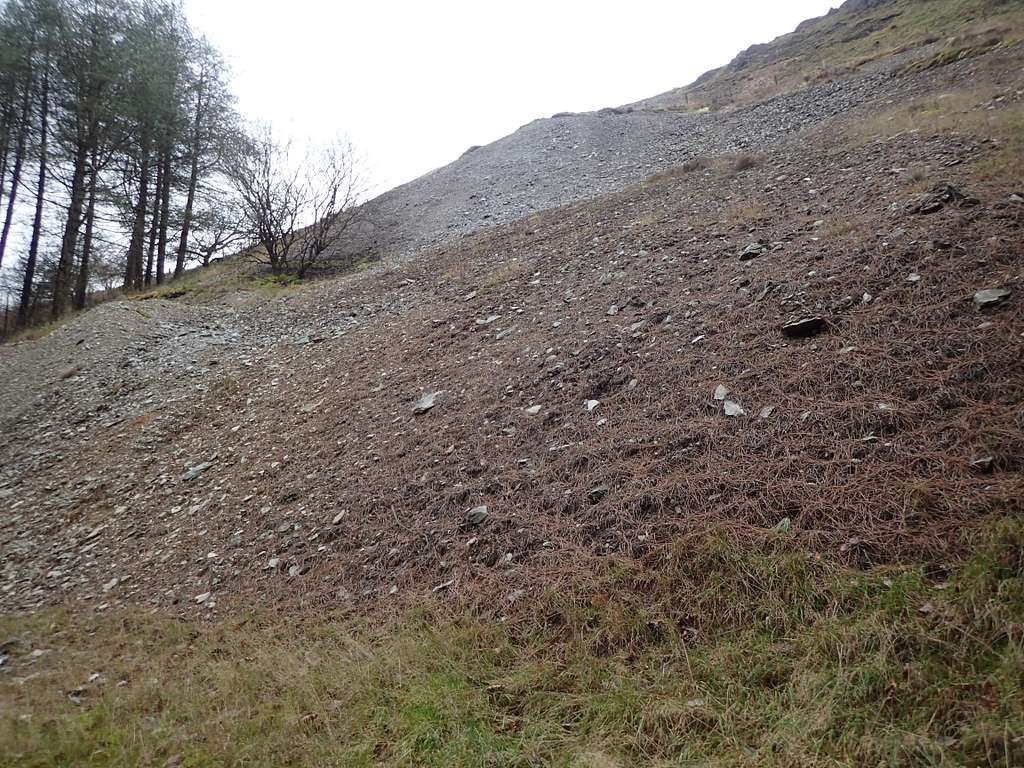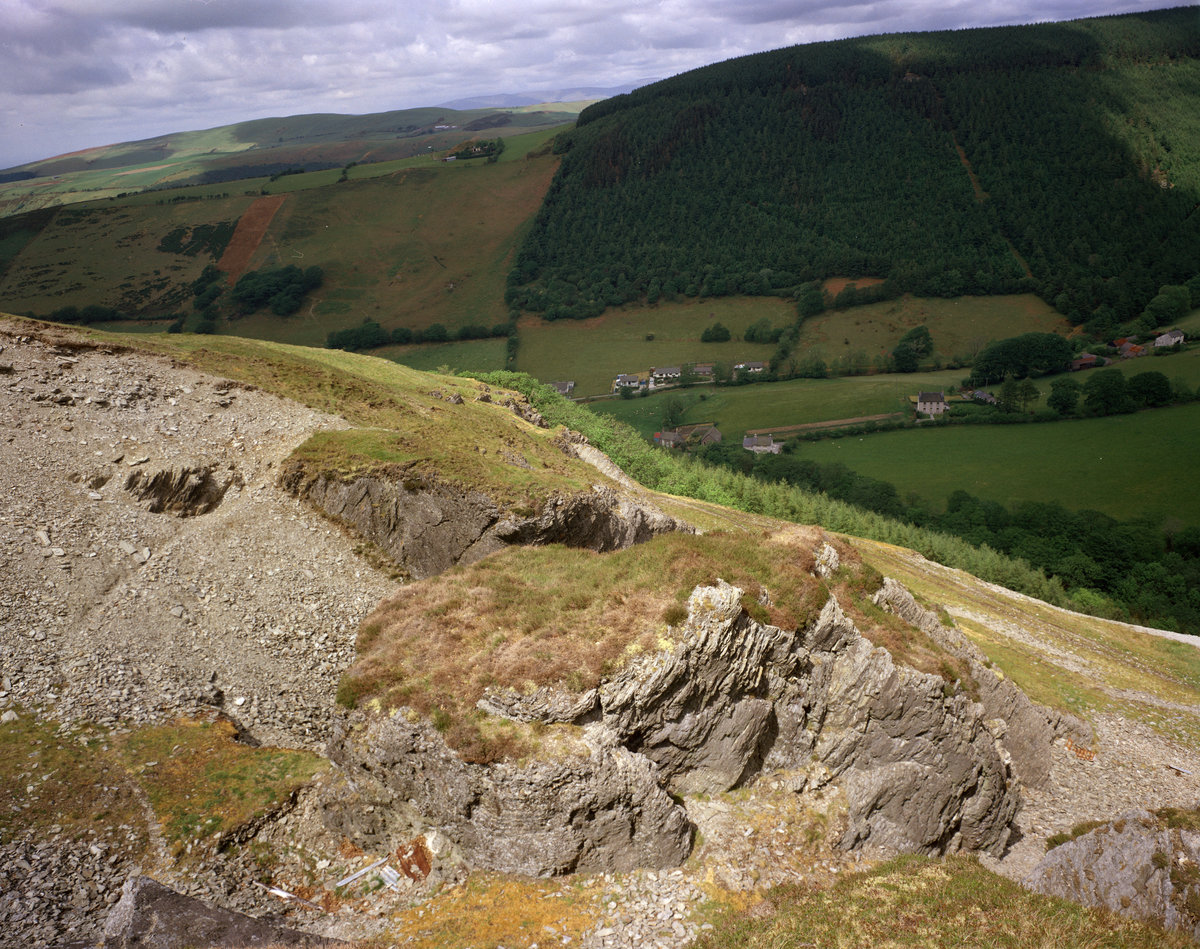Bushell’s Adit still visible, but the long Level Coed from the east is lost.Three shafts visible - Engine, Harris’s and Teague’s. Ancient opencast working extend up the hillside.
Possibly dates to the time of the fortifications on the hill. The vast majority of ore was removed prior to 1845 when official returns started being kept.
Lewis Morris mentions that the ‘Romans or BRitains wrought the lode in some places 40 or 50 yards deep without shafts’ He also states that during early 17C, Thomas Bushel acquired the lease and started a great drainage level, partly cut and cover.
Unusually for the area, at the tunr of the 19C, the mine escaped the attention of William Waller and the Mine Adventurers.
| Year | Activity |
|---|---|
| 1731 | Re-opened, the lode near George’s Shaft proving very rich with £12,000 being made from a 200m section of lode in one year. The ore was present from daylight to 110m depth, pumping being done by hand. |
| 1798 | Mine closed. |
| 1839 | Leased to Williams of Scorrier, In the western section, working were down 50 fm below Bushell’s deep adit. The long Level Coed was also being driven from the east. |
| 1842 | Taylor reports disappointing results. |
| 1844 | Taylor recommend cessation of further investment. |
| 1849 | Matthew & Absalom Francis obtain lease along with Court Grange Mine owners Lane & Oliver, John Humphrey becoming mine captain. Work to repair Level Coed. |
| c1850 | Mine promoted in Mining Journal as having copper worth £50 per ftm, with ‘giant courses of ore to be seen in every direction’. This was to be realised by unwatering the western section of the mine. |
| 1851 | Matthew Francis relocates to London to set up as mine promoter. |
| 1852 | Mine badly in debt after being neglected by Francis. Very little ore produced. |
| 1854 | Francis returns to Wales but the company continued its decline 53 tons of ore produced. |
| 1860 | Darrens East Mining Company try their luck. |
| 1867 | Proposal to drain western end by Great Cwmsymlog Company - but nothing done. |
| 1870-1884 | Run by engineer Thomas Girdwood, who made improvements and raised 700 tons of lead from the coveted ‘west end’ |
GCR: Post-orogenic (A1) lead-zinc-copper mineralization in Central Wales
External Links
Publications (35)
- (1850); Cardiganshire - MJ Articles; 2 pages
- (1922); BGS - Mineral Resources of GB (c1920s) Vol XX - Lead and Zinc: Cardiganshire & West Montogmeryshire; 242 pages
- (1990); WMS Newsletter Issue 23 Dec; 8 pages
- (1991); WMS Newsletter Issue 25 Dec; 5 pages
- (1992); WMS Newsletter Issue 26 Jun; 4 pages
- (1997); WMS Newsletter Issue 37 Dec; 11 pages
- (2001); WMS Newsletter Issue 45 Dec; 14 pages
- (2002); WMS Newsletter Issue 46 Apr; 23 pages
- (2002); WMS Newsletter Issue 47 Oct; 28 pages
- (2003); WMS Newsletter Issue 49 Winter; 32 pages
- (2004); WMS Newsletter Issue 50 Spring; 40 pages
- (2005); WMS Newsletter Issue 52 Spring; 28 pages
- Bick, D.E. (1991); Old Metal Mines of Mid-Wales, The; North of Goginan - Part 3; pp. 10-15
- Claughton, Peter (1994); PDMHS (Peak District Mines Historical Society) 12-3 Sum - Silver-Lead - A Restricted Resource - Technological Choice in the Devon Mines; 6 pages (54-59)
- Edited by D. J. Linton (2018); Welsh Mines & Mining - The Fascination that is in all Mining; 93 pages
- Foster-Smith, J.R.; NMRS (1979); British Mining 12 - Mines of Cardiganshire, The; ISBN 0 901450 14 6; pp.38,41-42.
- Hall, G.W. (2014); Welsh Mines & Mining - Metal Mining in Mid Wales 1822-1921; 131 pages
- Hall, G.W. (2014); Welsh Mines & Mining - Metal Mining in Mid Wales 1822-1921; 131 pages
- Highes, Simon J.S.; NMRS (1989); British Mining 40; Darren Mines, The
- Hughes, S.J.S.; NMRS (1981); British Mining 17 - Cwmystwyth Mines, The; ISBN 0 901450 20 0; pp.9,11.
- Hughes, S.J.S.; NMRS (1988); British Mining 35 - Goginan Mines, The; ISBN 0901450 33 2; pp.6,67,71.
- Hughes, Simon J.S. & Timberlake, Simon (1991); Early Metallurgical Sites in Great Britian No. 6 - Cwmystwyth; 12 pages
- Hughes, Simon J.S. (1976); Cardiganshire - Its Mines and Miners; 52 pages
- Hughes, Simon J.S. (2005); Relics of German migration into Cardiganshire.; 11 pages
- Hughes, Simon J.S. (2006); Miner's Lot, The - Version 2; 13 pages
- JNCC (2010); Mineralization of England and Wales; pp. 306-308
- Liscombe & Co (1880); Mines of Cardiganshire, Montgomereyshire & Shropshire; 52 pages
- NMRS; British Mining 34 - Memoirs 1987; pp.11.
- NMRS; British Mining 5 - Memoirs 1977; pp.16-17.
- NMRS; British Mining 71 - Memoirs 2002; pp.9,11.
- NMRS; British Mining 80 - Memoirs 2006; pp.81.
- NMRS; Newsletter Feb/1991; pp.3-5.
- Timberlake, Simon (1994); PDMHS (Peak District Mines Historical Society) 12-3 Sum - Archaeological and Circumstantial Evidence for early Mining in Wales; 11 pages (133-143)
- Timberlake, Simon (2015); PDMHS (Peak District Mines Historical Society) 19-3 Sum - New investigations and new ideas on Prehistoric-Roman metal mining and smelting in Wales; 10 pages (21-30)
- Tucker, D.G. (1977); Sacking of the Francises by John Taylor 1841-2, The; 5 pages (14-18)







